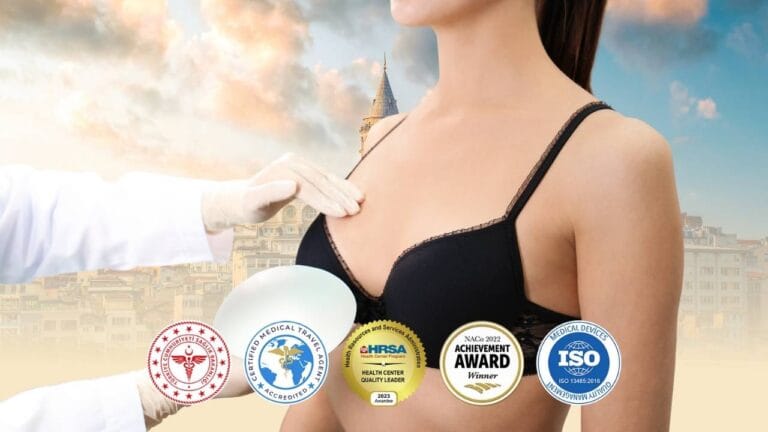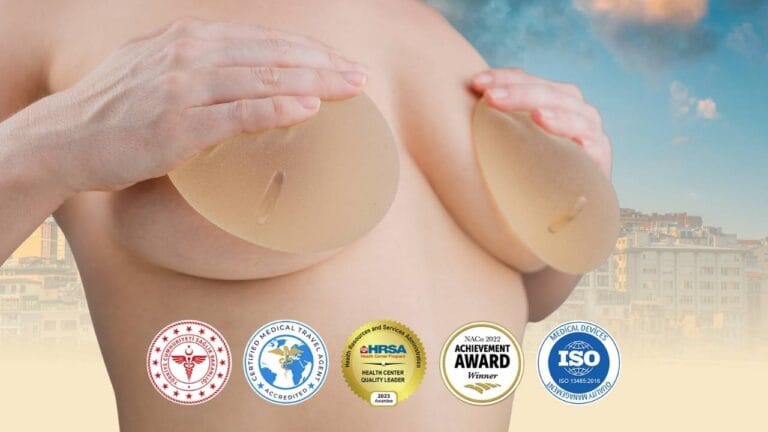Choosing between Round vs. Teardrop Implants is one of the most crucial decisions you will make during your breast augmentation journey, impacting both safety and the final aesthetic result. This decision must be based on your existing anatomy, tissue quality, and projection goals, not on trends.
Round Implants: Volume and Upper Pole Fullness
Round implants are symmetrical—meaning they have the same shape and volume distribution everywhere. They are the most common implant shape used globally. They are preferred when the goal is to:
- Achieve maximum fullness in the upper part of the breast (upper pole).
- Simplify the procedure, as rotation is not a risk.
- Achieve a good result when placed under the chest muscle (dual-plane placement is common).
Round implants can still achieve a natural look, especially when placed partially under the muscle, which compresses the top portion for a gradual slope.
Teardrop Implants: Anatomical Slope and Rotation Risk
Teardrop implants, also known as anatomical implants, are designed to mimic the natural slope of the breast (less full at the top, more full at the bottom). They are often considered for patients with minimal existing breast tissue. However, because they are asymmetrical (a specific shape), they introduce a unique risk:
- Need for Texture: Teardrop implants must have a textured surface to grip the surrounding tissue and prevent rotation.
- Rotation Risk: If a teardrop implant rotates, the breast contour will look severely distorted, requiring immediate surgical correction.
Clinic Care Center: Expert Warning (Rotation Risk)
The decision between Round and Teardrop is crucial. Teardrop (Anatomical) implants provide a more natural, gradual slope, but they must be precisely oriented and carry the unique, significant risk of ROTATION. If a Teardrop implant rotates, the breast contour is severely distorted, requiring immediate revision surgery. Round implants, conversely, cannot rotate (as they are symmetrical), making them the safer choice for many surgeons and patients, even though they give more upper pole fullness.
Round vs. Teardrop Implants: The Surgical Comparison
| Feature | Round Implants | Teardrop (Anatomical) Implants |
|---|---|---|
| Shape | Symmetrical (equal fullness everywhere) | Anatomical (less full at the top, sloped) |
| Risk of Rotation | None (They cannot rotate) | Primary Risk (Requires revision if it rotates) |
| Upper Pole Fullness | Maximum fullness (“pushed up” look) | Natural transition (less visible implant outline) |
| Ideal Candidate | Patients seeking maximum volume; often suitable for placement under the muscle. | Patients with minimal tissue seeking a very subtle, natural contour. |
Potential Risks & Realistic Expectations
We must be transparent: there is no ‘guaranteed’ outcome or ‘risk-free’ surgery. Teardrop implants carry the unique risk of rotation (asymmetry), which requires immediate surgical correction. All implants carry the general risks of Capsular Contracture (hardening), rupture, and BII (Breast Implant Illness). The realistic expectation is a significant improvement in size and shape, provided the implant type is matched precisely to your unique anatomical measurements.
Frequently Asked Questions (FAQ)
Which is more popular, round or teardrop?
Round implants are significantly more popular globally due to their versatility and the absence of a rotation risk.
Can round implants look natural?
Yes, round implants placed partially under the muscle (dual-plane) are compressed at the top and can yield a very natural-looking result.
What happens if a teardrop implant rotates?
Rotation causes the breast to look severely distorted (the wide base points up or sideways), requiring immediate surgery to reposition it.
Do round implants feel softer?
The softness is determined by the implant’s gel firmness (cohesivity), not the shape; however, round implants are available in a wider range of gels.
What is the difference between smooth and textured implants?
Smooth implants move more naturally but have a higher risk of capsular contracture; textured implants adhere to tissue but carry the rotation risk (especially teardrop).
Is the recovery different for each shape?
No, the recovery is determined by the implant *placement* (over or under the muscle), not the shape.
Are teardrop implants more expensive?
Teardrop (anatomical) implants are often slightly more expensive due to their specific engineering and unique features.
What is the rotation risk in textured implants?
The rotation risk in teardrop implants is reduced by their textured surface, which helps them grip the tissue, but the risk remains if the pocket is too large.
Which Implant is Best for Your Anatomy?
A safe result starts with precise measurement. The experts at Clinic Care Center will analyze your chest width, projection, and existing tissue. Contact us today for an honest, expert consultation to determine the shape that suits your body best.
Also Read:
Breast Augmentation
Breast Lifting
Breast Reduction
Breast Implant Removal





